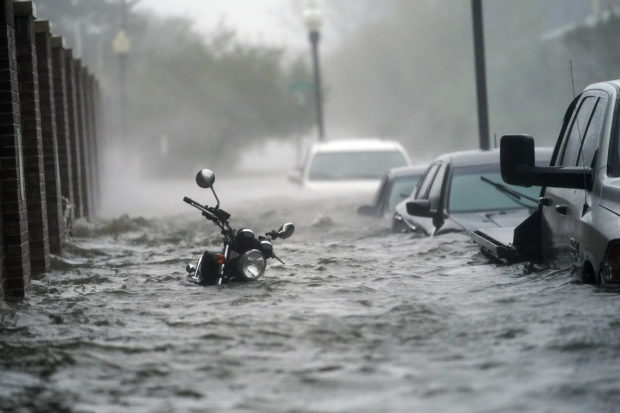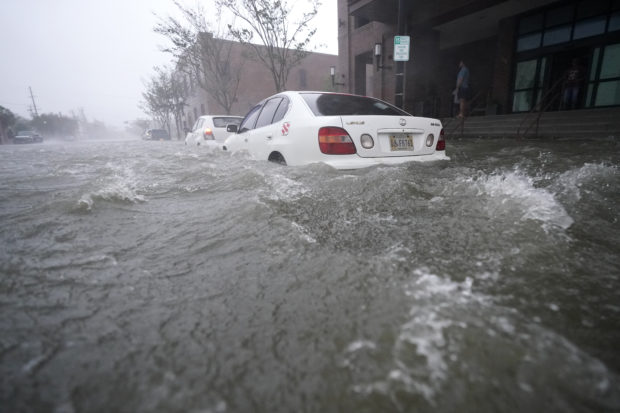Hurricane Sally unleashes flooding, hundreds rescued

Floodwaters move on the street, Wednesday, Sept. 16, 2020, in Pensacola, Fla. Hurricane Sally made landfall Wednesday near Gulf Shores, Alabama, as a Category 2 storm, pushing a surge of ocean water onto the coast and dumping torrential rain that forecasters said would cause dangerous flooding from the Florida Panhandle to Mississippi and well inland in the days ahead.(AP Photo/Gerald Herbert)
PENSACOLA, Fla. — Hurricane Sally lumbered ashore near the Florida-Alabama line Wednesday with 105 mph (165 kph) winds and rain measured in feet, not inches, swamping homes and forcing the rescue of hundreds of people as it pushed inland for what could be a slow and disastrous drenching across the Deep South.
Moving at just 3 mph (5 kph), or about as fast as a person can walk, the storm made landfall at 4:45 a.m. close to Gulf Shores, Alabama, about 30 miles (50 kilometers) from Pensacola, Florida. It accelerated to a light jog as it battered the Pensacola and Mobile, Alabama, metropolitan areas encompassing nearly 1 million people.
It cast boats onto land or sank them at the dock, flattened palm trees, peeled away roofs, blew down signs and knocked out power to more than a 540,000 homes and businesses. A replica of Christopher Columbus’ ship the Nina that had been docked at the Pensacola waterfront was missing, police said.
Sally tore loose a barge-mounted construction crane, which then smashed into the new Three Mile Bridge over Pensacola Bay, causing a section of the year-old span to collapse, authorities said. The storm also ripped away a large section of a fishing pier at Alabama’s Gulf State Park on the very day a ribbon-cutting had been scheduled following a $2.4 million renovation.
By the afternoon, authorities in Escambia County, which includes Pensacola, said at least 377 people had been rescued from flooded areas. More than 40 people trapped by high water were brought to safety within a single hour, including a family of four found in a tree, Sheriff David Morgan said.
Article continues after this advertisementAuthorities in Pensacola, where Sally turned some streets into white-capped rivers for a time, said 200 National Guard members would arrive Thursday to help. Curfews were announced in Escambia County and in some coastal Alabama towns.
Article continues after this advertisementBy early afternoon, Sally had weakened into a tropical storm, with winds down to 70 mph (110 kph). Showers still fell in parts of the stricken area Wednesday evening, and the storm was expected to generate heavy rain farther inland Thursday as it moved over Alabama and into Georgia. For much of the day, it moved at just 5 mph (7 kph), concentrating the rainfall.

Flood waters move on the street, Wednesday, Sept. 16, 2020, in Pensacola, Fla. Hurricane Sally made landfall Wednesday near Gulf Shores, Alabama, as a Category 2 storm, pushing a surge of ocean water onto the coast and dumping torrential rain that forecasters said would cause dangerous flooding from the Florida Panhandle to Mississippi and well inland in the days ahead.(AP Photo/Gerald Herbert)
Morgan estimated thousands will need to flee rising waters in the coming days. Escambia officials urged residents to rely on text messages for contacting family and friends to keep cellphone service open for 911 calls.
“There are entire communities that we’re going to have to evacuate,” the sheriff said. “It’s going to be a tremendous operation over the next several days.”
West of Pensacola, power poles leaned halfway over in Perdido Key, Florida, as Joe Mirable arrived at his real estate business to find the two-story building shattered. Digging through the ruins, Mirable pointed out a binder labeled “Hurricane Action Plan.”
“I think the professionals got this one wrong,” he said before the wind blew away his hat.
More than 2 feet (61 centimeters) of rain was recorded near Naval Air Station Pensacola, and nearly 3 feet (1 meter) of water covered streets in downtown Pensacola, the National Weather Service reported.
“It’s not common that you start measuring rainfall in feet,” said forecaster David Eversole.
Sally was the second hurricane to hit the Gulf Coast in less than three weeks and the latest blow in one of the busiest hurricane seasons ever. Forecasters have nearly run through the alphabet of storm names with 2 1/2 months still to go. At the start of the week, Sally was one of a record-tying five storms churning simultaneously in the Atlantic basin.
Like the wildfires raging on the West Coast, the onslaught of hurricanes has focused attention on climate change, which scientists say is causing slower, rainier, more powerful and more destructive storms.
An emergency crew rescued two people on Dauphin Island, Alabama, after the hurricane ripped the roof off their home and the rest of the house began to crumble. “As things started to peel off and fall apart, they got scared and called for assistance,” Mayor Jeff Collier said. He said no one was injured.
In Orange Beach, Alabama, the wind blew out the walls in one corner of a condominium building, exposing at least five floors, video posted online showed. At least 50 people were rescued from flooded homes and taken to shelters, Mayor Tony Kennon said.
“We got a few people that we just haven’t been able to get to because the water is so high,” Kennon said. “But they are safe in their homes. As soon as the water recedes, we will rescue them.”
Sally’s crawl made it hard to predict where it would strike. Just two days before landfall, the storm was forecast to hit New Orleans — 140 miles (225 kilometers) west of where it came ashore.
So Robert Lambrisky and his husband were caught somewhat off guard when the hurricane shook their door before daybreak and forced rainwater inside their home in Sanders Beach near Pensacola.
“We had some warning, but this was just such a strange storm,” Lambrisky said. “So all of this preparing that you do, when you know the storm is coming, was something we only half did because we were convinced the storm wasn’t going to hit us.”
Sally’s effects were felt all along the northern Gulf Coast. Low-lying properties in southeastern Louisiana were swamped by the surge. Water covered Mississippi beaches and parts of the highway that runs parallel to them.
Hurricane Laura pummeled southwestern Louisiana on Aug. 27. Thousands of people were still without power from that storm, and some were still in shelters.
Meanwhile, far out in the Atlantic, Teddy became a hurricane Wednesday with winds of 100 mph (160 kph). Forecasters said it could reach Category 4 strength before closing in on Bermuda, which took a direct hit from Hurricane Paulette only days ago.